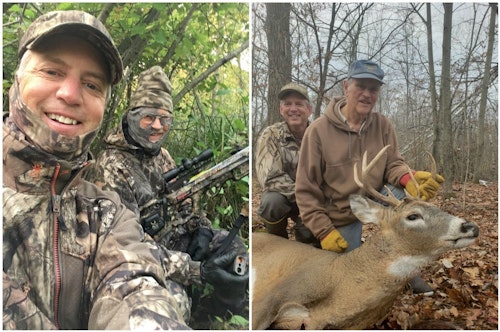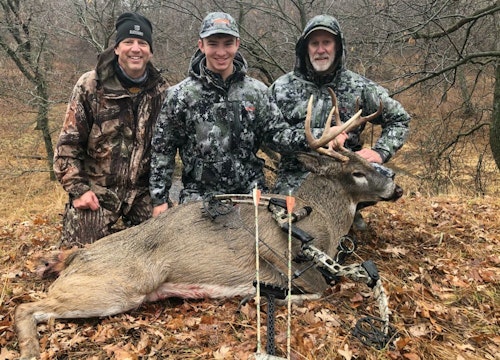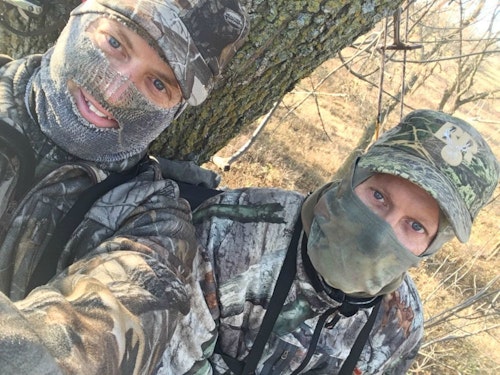As any avid deer hunter knows, one of the hardest decisions to make is staying off a whitetail property to avoid too much hunting pressure. If you have exclusive permission on a tract, or if you own your own property and hunt it solo, then the only way to reduce hunting pressure on the land is to hunt smarter and/or hunt less. However, most outdoorsmen and women are in the field with family and friends, which means reducing hunting pressure is more complicated.
This is the situation on the properties I hunt in Wisconsin and South Dakota. In Wisconsin I’m pursuing whitetails on family land, and depending on the day, there could be as many as six of us in the field simultaneously. We don’t own a lot of property, so six people in the woods at the same time is noticed by the local whitetails. Whether we like to admit it or not, it’s a fact. In South Dakota I’m pursuing whitetails with my son and a buddy or two. Again, the property isn’t large, so when three or four of us are in the field simultaneously, the deer know it.
How do I know that hunting pressure is affecting our results? Simple — deer sightings go down each day we’re in the woods. Example: If we hunt three consecutive days, and someone is watching a trail that leads to a nearby food plot, the number of deer visiting that plot during daylight hours goes from 10 to 5 to 1 (or zero). We’ve seen this happen so many times in the past couple decades that it’s expected.
So, how can you cut hunting pressure in half and still allow everyone to be in the field each day? Hunt in pairs.
I started using this strategy during 2020 for reasons other than trying to reduce hunting pressure. In Wisconsin, I simply wanted to spend more time with my father, who was born in 1937. He’s in good health, but during these tough times due to the pandemic, the realization that none of us will live forever was top of mind. I wanted to hunt with him — sit and talk with him in natural ground blinds and two-person ladders. Not only was it a blast, but I soon realized that we were cutting overall hunting pressure in half by sitting together.

In South Dakota, my 17-year-old son Elliott joined me for the first time in 2020. It was Elliott’s first season on the property, so it made sense to hunt together. I could lead the way in the predawn darkness to find treestands and ground blinds with minimal impact. And similar to hunting with my dad, it was fun to visit with my son while waiting on whitetails. When Elliott wasn’t hunting with me, I often sat in two-person ladder stands or ground blinds with a buddy. Again, I soon realized that by sitting together, we were cutting overall hunting pressure in half.
In 2021, I will overhaul my treestand and ground blind strategy in Wisconsin and South Dakota to better accommodate hunting in pairs. Currently the vast majority of my ambushes are set up for a single hunter; this will change. In South Dakota, for example, I have 24 options (treestands and natural ground blinds) spaced out along a mile-long river-bottom. Only six of these spots accommodate two hunters. When the 2021 deer season begins, I hope to reduce the total number of options from 24 to 12, but I want every one of the 12 options to be ready for two hunters. This means either two-person ladders, two portable treestands placed in a single tree or adjacent trees, or natural ground blinds built for two hunters.
I was sitting in a natural ground blind on Wisconsin public land with my dad on Oct. 31, 2020, when he arrowed a rutting buck at 9 yards. It was more exciting than killing a whitetail myself. I didn’t even carry my bow into the field that morning even though I had an open tag.
In South Dakota I was sitting beside Elliott in a tree on Nov. 8, 2020, when he arrowed his first deer with a compound bow. Again, it was thrilling, and I had left my bow in the truck.
A few days later in South Dakota, I was sitting with my friend Bill in a treestand when we had a mature 4x4 approach a doe decoy at 15 yards. That buck escaped due to equipment failure (rotating peep, so no shot), but it was a memory we’ll never forget.

Next deer season I recommend looking at your hunting strategy to see if it makes sense to double-up during morning and evening sits in the whitetail woods. The way I see it, doing so cuts your hunting pressure in half. And you just might find that it doubles your hunting pleasure, too.







